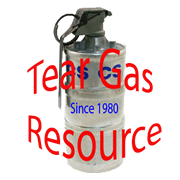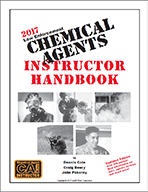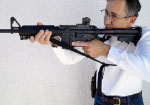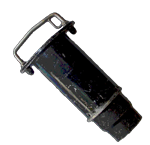Chemical Agents are generally considered non-lethal; normal exposure in the open causes no known lasting effects. However like any chemical, they can have an effect on the human body. Exposure to large doses of chemical agents can cause serious injury or death. In the Middle East today many people are claiming to be injured from tear gas used in the open.
Chemical agent toxicity discussed below generally refers to CN, CS and CR that is released by chemical agent devices in the form of very fine solid particles that is like smoke or dust. In the majority of the uses of these agents, the amount of agent in the atmosphere does not reach levels close to dangerous concentrations. When chemical agents are released in enclosed spaces the possibility of overdose must be considered.
Examples of this might be a barricaded gunman or prisoners in a jail setting. Many variables affect the toxicity equation in a given situation.
- Level of physical activity that influences depth of respiratory effort.
- The amount of chemical agent concentration in the air.
- The length of time of exposure.
- The volume of enclosed space.
- Temperature
- Air Circulation
- Entry points of chemical agent into the enclosed environment.
The amount of chemical agent absorbed into a person's system, normally called a dosage, depends largely on the degree of physical activity occurring at the time of exposure. The level of physical activity is translated into the depth of respiratory effort needed to maintain adequate oxygen levels.
Simply put, how hard a person breathes to maintain adequate oxygen supply for the body influences how much agent is taken into the body.
Another variable is the length of exposure to the chemical agent. The response of the human body varies greatly depending on the size, shape, age and overall physical condition of the individual.
Obviously the greater the concentration of chemical agent breathed in, the higher the concentration accumulated in the body. The concentration (often expressed in grams per thousand cubic feet) depends on the weight of the agent released in the room, and the combined factors listed above.
Because of these considerations, it is not possible to offer guidelines on how much chemical agent to use or what type to use in any specific situation. Formulas have been developed by the U.S. Army however, in an attempt to determine what concentration levels would cause fifty percent of the people in a contaminated atmosphere to perish. Because of the variables discussed above, this formula is only a guide, and should not be construed or used as the sole determiner of chemical agent usage and deployment.
An I-Phone and Android application have been developed to help the SWAT operator find a reasonable amount of chemcial agent to place inside a structure. Again you should never use this as a sole determiner of chemical agent use.
From Sandia Labs:
o-Chlorobenzylidene malononitrile (CS) is one of the most common training and riot-control lacrimating agents in use. It is a clear white solid that is dispersed as a colorless particulate suspension with an acrid pepper-like smell that is immediately irritating to the eyes and upper respiratory tract. Evaluation of the toxicity of CS indicates that this material is primarily a severe mucous membrane irritant. CS acts directly on the mucous membranes to produce irritation, burning, and pain in the eyes, nose, throat, and respiratory tract. Upon exposure immediate initial effects include lacrimation (tear flow), blepharospasm (tightly closed eyelids), and conjunctivitis (redness and inflammation) of the eyes.
The most incapacitating effects are felt in the respiratory tract and includes sneezing, coughing, salivation, congestion of the nose and wall of the pharynx, chest constriction, and a feeling of suffocation. A burning sensation of the skin that is accentuated by moisture can be detected following an acute exposure to CS powder. Repeated skin exposure has been shown to produce sensitization dermatitis. The maximum concentration of CS that has been tolerated by trained military troops without respiratory protection is 10 mg/m3 for less than one minute.
This concentration is several orders of magnitude less than the concentration of CS smoke that is capable of producing fatal damage in the most sensitive animal model (approximately 2500 - 3500 mg/m3 ) whether this is the result of a high acute exposure or a lower chronic exposure. Therefore it is expected, and has been the experience of those working with and using CS, that a man will remove himself from the exposure, if physically able (i.e. not in a locked room, not seriously injured), long before being exposed to incapacitating or lethal doses.





